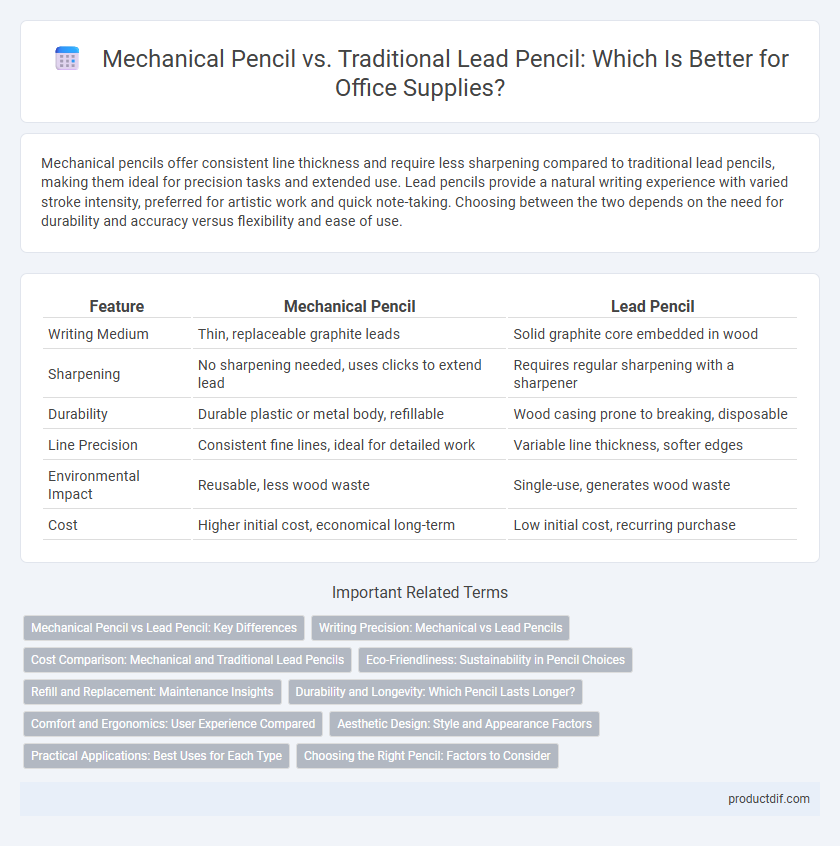Mechanical pencils offer consistent line thickness and require less sharpening compared to traditional lead pencils, making them ideal for precision tasks and extended use. Lead pencils provide a natural writing experience with varied stroke intensity, preferred for artistic work and quick note-taking. Choosing between the two depends on the need for durability and accuracy versus flexibility and ease of use.
Table of Comparison
| Feature | Mechanical Pencil | Lead Pencil |
|---|---|---|
| Writing Medium | Thin, replaceable graphite leads | Solid graphite core embedded in wood |
| Sharpening | No sharpening needed, uses clicks to extend lead | Requires regular sharpening with a sharpener |
| Durability | Durable plastic or metal body, refillable | Wood casing prone to breaking, disposable |
| Line Precision | Consistent fine lines, ideal for detailed work | Variable line thickness, softer edges |
| Environmental Impact | Reusable, less wood waste | Single-use, generates wood waste |
| Cost | Higher initial cost, economical long-term | Low initial cost, recurring purchase |
Mechanical Pencil vs Lead Pencil: Key Differences
Mechanical pencils offer consistent line thickness and do not require sharpening, making them ideal for precision tasks and long-term use, while lead pencils have variable line widths and need frequent sharpening but provide a tactile, natural drawing experience. Mechanical pencils use replaceable graphite leads encased in a rigid barrel, which improves durability and cleanliness compared to the wood-cased lead pencils. The choice between mechanical and lead pencils depends on user preference for convenience, precision, and the type of writing or drawing activity.
Writing Precision: Mechanical vs Lead Pencils
Mechanical pencils offer superior writing precision due to their consistent fine tip size, typically ranging from 0.3mm to 0.7mm, enabling detailed and clean lines ideal for drafting and detailed note-taking. In contrast, traditional lead pencils provide variable line thickness influenced by pressure and sharpening, resulting in less uniformity but allowing for shading and artistic flexibility. For tasks requiring precise, uniform lines, mechanical pencils are the preferred choice in office and technical environments.
Cost Comparison: Mechanical and Traditional Lead Pencils
Mechanical pencils generally have a higher upfront cost due to their durable construction and refillable lead mechanism, while traditional lead pencils are cheaper per unit but require frequent replacement. Over time, mechanical pencils prove more cost-effective for heavy users because lead refills are less expensive and generate less waste compared to continuously buying new wooden pencils. Businesses and students seeking long-term savings often prefer mechanical pencils despite the initial investment.
Eco-Friendliness: Sustainability in Pencil Choices
Mechanical pencils reduce waste by using refillable lead, making them a sustainable choice compared to traditional lead pencils, which require constant sharpening and eventual disposal. Lead pencils, though biodegradable, often contribute to wood consumption and waste when discarded frequently. Opting for mechanical pencils with recycled or sustainably sourced materials further enhances eco-friendliness in office supply decisions.
Refill and Replacement: Maintenance Insights
Mechanical pencils offer convenient refill options with standardized lead sizes, allowing for precise replacement and reducing waste compared to traditional lead pencils that require sharpening and eventual wood casing disposal. Lead pencils need to be regularly sharpened to maintain a fine point, leading to faster material consumption and frequent purchase of new pencils. Mechanical pencils generally provide longer-lasting usability through simple lead refills, making them a more sustainable and cost-effective choice in office supply maintenance.
Durability and Longevity: Which Pencil Lasts Longer?
Mechanical pencils offer superior durability due to their sturdy plastic or metal casing, which protects the internal lead from breaking and extends overall pencil lifespan. Lead pencils, while biodegradable and often cheaper, rely on wood casing that wears down with sharpening, reducing longevity compared to mechanical options. In terms of lasting longer under consistent use, mechanical pencils provide a more sustainable and cost-effective solution for prolonged writing or drawing tasks.
Comfort and Ergonomics: User Experience Compared
Mechanical pencils provide superior comfort with consistent line thickness and reduced hand strain due to their lightweight, balanced design and cushioned grips. Lead pencils offer natural tactile feedback and variable line darkness, but require frequent sharpening that can interrupt workflow and cause discomfort over extended use. Ergonomically, mechanical pencils are preferred for prolonged writing tasks due to their precision and ease of handling.
Aesthetic Design: Style and Appearance Factors
Mechanical pencils feature sleek, modern designs with durable metal or plastic barrels that appeal to professionals and students seeking a polished look. Lead pencils offer a classic, natural wood finish that provides a timeless aesthetic favored for artistic and traditional writing purposes. Both options integrate ergonomic grips and varied color palettes to enhance comfort and personal style preferences.
Practical Applications: Best Uses for Each Type
Mechanical pencils offer precision and consistency for detailed technical drawings, note-taking, and professional drafting, making them ideal for students, architects, and engineers. Lead pencils, favored for their versatility and ability to produce varied shading, are perfect for artists, designers, and casual writing tasks. Choosing between mechanical and lead pencils depends on the need for sharp, uniform lines versus flexibility in line thickness and texture.
Choosing the Right Pencil: Factors to Consider
When choosing between a mechanical pencil and a lead pencil, consider factors such as precision, convenience, and maintenance; mechanical pencils provide consistent line width and require minimal sharpening, making them ideal for detailed work and frequent use. Lead pencils offer variable line thickness and a tactile drawing experience, preferred in artistic settings where shading and texture are important. Durability, cost-effectiveness, and environmental impact also influence the decision, with mechanical pencils being reusable and lead pencils often disposable.
Mechanical Pencil vs Lead Pencil Infographic

 productdif.com
productdif.com